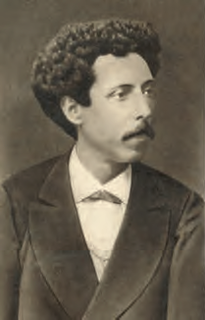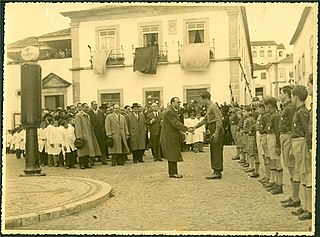Related Research Articles

Dona Maria II "the Educator" or "the Good Mother", reigned as Queen of Portugal from 1826 to 1828, and again from 1834 to 1853. Born in Rio de Janeiro, she was the first child of Emperor Dom Pedro I of Brazil and Empress Dona Maria Leopoldina, and thus a member of the House of Braganza. One of the two surviving children born when Pedro was still heir apparent to Portugal, she inherited Portuguese titles and was placed in the line of succession to the former Portuguese throne, even after becoming a member of the Brazilian Imperial Family, from which she was excluded in 1835 after her definitive ascension to the Portuguese throne.

Afonso, Prince of Portugal was the heir apparent to the throne of Portugal. He was born in Lisbon, Portugal, and died in a horse-riding accident on the banks of the river Tagus.

António Caetano de Abreu Freire Egas Moniz, known as Egas Moniz, was a Portuguese neurologist and the developer of cerebral angiography. He is regarded as one of the founders of modern psychosurgery, having developed the surgical procedure leucotomy—better known today as lobotomy—for which he became the first Portuguese national to receive a Nobel Prize in 1949.

Theresa Owana Kaʻōhelelani Laʻanui was a descendant of Kalokuokamaile, the eldest brother of Kamehameha I. She was a member of the House of Laʻanui, a collateral branch of the House of Kamehameha.

Nevada Stoody Hayes, sometimes called Nevada of Braganza, was an American socialite who became the wife of Infante Afonso of Braganza, Duke of Porto, whose nephew, Manuel II, was the last king of Portugal. She was the Princess Royal of Portugal, but never accepted as a member of the exiled Portuguese royal family, yet by Portuguese law her marriage to Afonso was legal.

João Teixeira de Faria, known also as João de Deus, is a Brazilian purported medium, "psychic surgeon" and convicted sex offender. He was based in Abadiânia, Brazil, where he ran the Casa de Dom Inácio de Loyola, a "spiritual healing center". He has received media coverage on CNN, ABC News and The Oprah Winfrey Show, amongst others. James Randi and Joe Nickell have exposed his healing procedures as involving nothing more than carnival tricks, and there is no evidence that the benefits that have been reported by patients are anything more than placebo effects.

Dr José Tomás de Sousa Martins was a doctor renowned for his work for the poor in Lisbon, Portugal. After his death, a secular cult arose around his personality in which he is thanked for "miraculous" cures.

Anandibai Gopalrao Joshi was one of the first Indian female doctors of western medicine alongside Kadambini Ganguly. She was the first woman from the erstwhile Bombay presidency of India to study and graduate with a two-year degree in western medicine in the United States. She was also referred to as Anandibai Joshi and Anandi Gopal Joshi.

The Blue Afternoon (1993) is a novel by William Boyd. It won the Sunday Express Book of the Year in the year of its publication and the Los Angeles Times Book Prize for Fiction.
Hugo José Jorge O'Neill was the head of the Clanaboy O'Neill dynasty, whose family has been in Portugal since the 18th century.
Samuel Nunez (1668–1744) was a Portuguese physician and among the earliest Jews to settle in North America.

Baltazar Leite Rebelo de Sousa, GCIH was a Portuguese politician and a former minister and member of parliament and medicine professor.

Wilhelm or William Hillebrand was a German physician. He practiced medicine in several different countries, including for over 20 years in the Hawaiian islands. In 1850, Hillebrand lived at what is now Foster Botanical Garden in Honolulu and gained acknowledgement as a botanist.

Dwight Baldwin was an American Christian missionary and medical doctor on Maui, one of the Hawaiian Islands, during the Kingdom of Hawaii. He was patriarch of a family that founded some of the largest businesses in the islands.

Dona Maria Adelaide of Braganza, Infanta of Portugal was a member of the royal house of Braganza, daughter of Miguel, Duke of Braganza and Princess Maria Theresa of Löwenstein-Wertheim-Rosenberg.
Dr. Jesse Bennett was the first American physician to perform a successful Caesarean section, which he performed on his own wife at the birth of their only child on January 14, 1794.
Dr. Breen's Practice is a novel, one of the earlier works by American author and literary critic William Dean Howells. Houghton Mifflin originally published the novel in 1881 in both Boston and New York. Howells wrote in the realist style, creating a faithful representation of the commonplace, and in this case describing everyday mannerisms that embody the daily lives of middle-class people.

Lilian Violet Cooper was a British-born medical practitioner in Queensland, Australia. She was the first female doctor registered in Queensland.

Helen Strong Carter (1866–1945) was First Lady of the Territory of Hawaii from 1903 to 1907. Her philanthropic activities included the establishment of the Strong-Carter Dental Clinic at Palama Settlement in Hawaii, and the Strong Memorial Hospital in Rochester, New York.

Elísio de Moura Azevedo, was a physician and professor Portuguese psychiatrist and first president of the College of Physicians in 1939.